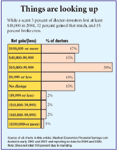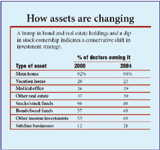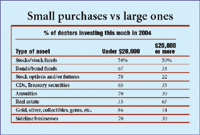Article
Financial Survey: Doctor investors bounce back
Our latest numbers show that you've moved into more-conservative—as well as more-creative—ways of multiplying your savings.

Doctors did better: Respondents to this year's survey reported a typical gain of 10 percent, or $30,000-quite impressive compared to the –2.1 percent for the market at large in the same time period-and nearly a quarter of the winners chalked up at least $100,000. Overall, 78 percent of doctors reported investment gains, while just 7 percent suffered a net loss. That compares to gains for just 35 percent and losses for 45 percent in our 2001 survey.
When we last surveyed doctors, our respondents were still licking their all-too-fresh wounds from the tech bubble burst that followed the euphoria of the late '90s. But cautious optimism has slowly returned.

You can almost hear the exuberance of the doctors who reaped considerable rewards. An FP in Ohio took little risk with index funds and still earned 18 percent. Then there's California internist and day-trader David Winn, who writes, "My individual stocks gained 51 percent for the year, and my mutual fund holdings in retirement accounts gained 8 to 15 percent, on average." A physician in Minnesota saw his foreign mutual fund shares go up 42 percent, and an FP in the same state bought SkyTerra Communications when it was selling for a few dollars a share and watched it appreciate more than 1,000 percent! Another FP in Iowa hit pay dirt when he sold XM Satellite Radio Holdings and realized a 1,200 percent gain!
But these were the exceptions. Most of these once-bitten-twice-shy investors opted for the more-conservative, risk-averse path. Only 10 percent are invested in high-risk investments, and that figure dropped to 5 percent for physician-respondents 50 and older. Many have taken shelter in large-cap stocks and stock and bond funds, putting an end to the days when all their eggs lay in a few tech baskets.
Respondents are well aware that stocks can be both their best friend and their worst enemy. When asked to name their biggest investment success, almost half the physicians mentioned mutual funds and individual equities of well-established companies in the oil, energy, manufacturing, insurance, and communications sectors. Yet when asked to describe their biggest investment disappointment, many also mentioned stocks (notably pharmaceuticals and biotech companies). In fact, 22 percent of those owning stocks have their entire stock portfolio in mutual funds.

That said, many physicians are still financially self-reliant. With easy access to online research and advice, 40 percent of physicians-50 percent of those 35 to 39-are turning to Web sites to help them select their own investments. When it comes to the actual buying and selling, though, just under one-third are trading online. That proportion increases with income and among the 35-to-49-year-olds, where 37 percent invest in cyberspace. When it comes to monitoring portfolios, the Internet is used by 56 percent overall and by 73 percent in that web-savvy 35-to-39 age group, compared to 67 percent of those in the same age bracket four years ago.
Although just over half of respondents rely on paid financial advisers, many express disenchantment with them. Aside from gripes about inaccessibility and lack of personal attention, respondents complain about excessive commissions and fees, and question their advisers' loyalties. They complain about an "investment bias" toward proprietary products that pad the broker's own wallet and his firm's coffers.
Says one FP near Lancaster, PA, "They seem reluctant to act on any of their clients' wishes to move assets from accounts they're being paid for. When the market was bleeding to death, it was like pulling teeth to get my tax-sheltered annuities switched into fixed income options, and it resulted in a loss of 30 to 40 percent. I'll never make this back in the time remaining for me to practice." Many doctors also express dissatisfaction with advisers' poor picks. One FP in Florida grumbles, "I get charged for generic advice I can get on my own."

Quite a few count their homes as their biggest investment success in 2004. No surprise, when you consider that the average US home price rose 37 percent from 2000 to 2004. And some of the three out of 10 doctors who own their medical offices consider that an investment success.
But an increase in fair market value isn't an investment coup unless you sell the property and realize the profits. So 39 percent have branched out into investment real estate (not including their homes and medical offices), slightly more than reported in our 2001 survey.





